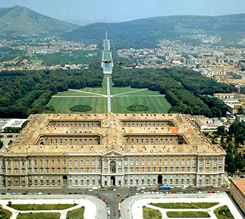CASERTA
Present day Caserta is a modern agricultural town reflecting the major rebuilding carried out in Italy during the 1950’s. A few older buildings remain the Church and Monastery of Sant’Agostino in Via Mazzini and the former residence of the Acquaviva family in Piazza Vanvitelli. However the main reason to visit Caserta is the Royal Palace, conceived by Charles III, it is the Bourbon monarchs’ answer to Versailles. The palace is one of the richest and most fascinating royal residences, with a vast collection of furniture and objects of art, particularly noteworthy are the beautiful Park and the English Garden.
Not far from the palace is Caserta Vecchia (Old Caserta) a lovely medieval village on the slopes of Monte Virgo where you can visit the Cathedral of San Michele, a fine example of Sicilian-Muslim architecture.
Reggia di Caserta (Royal Palace):

This royal palace is the finest example of 18th century Bourbon royal living. The Architect Luigi Vanvitelli devoted 20 years to this project, working under Charles III. It is said that Charles II was envious of Louis XIV’s creation of Versailles; Vanvitelli was given the task of transforming a country hunting lodge into a larger-scale replica of Versailles. The result is vast: four interconnected courtyards, miles of draughty corridors connecting 1200 rooms, all surrounded by an enormous park. Impressive to say the least if not only for its sheer size, the palace can be viewed from miles away in the flat countryside. The interior of the palace is less impressive, with room after room of heavy gilded furniture and overdone portraits of some incredibly ugly royalty. However the main staircase is breathtaking – a kaleidoscope of marble inlay and long, wide steps making you glide rather than walk, evoking a feeling of grandeur and nobility.
The royal apartments are complimented by the royal bathrooms with enormous gold-plated bathtubs- typical of the Bourbon mentality – big meant good and the more gold the better.
The Park:
Luigi Vanvitelli designed this famous park, one of the last examples of the regimented garden in the Italian or French style. The long central axis is designed on descending levels, creating a remarkable effect with pools and fountains ornamented with splendid sculptures. The culmination being the Grand Cascata waterfall, almost 260 ft. high also known as the Fountain of Diana. Nearby is the English Garden, thought to be the first of its kind in Italy. The idea was suggested to Queen Maria Carolina by her dear friend Lord Hamilton and the landscaping work was begun in 1768. The English approach being much less ordered and formal.
Caserta Vecchia (Old Caserta):
Due to its remarkably well preserved medieval character. This small hilltop town was probably founded by the LoThe town of Old Caserta is fascinating dmbards in the 8th century when it cam under Norman rule.
Caserta Vecchia revolves around the main square where the Cathedral of San Michele stands. Nearby is the Gothic church of Annunziata with a marble portal opening onto a 17th century portico. On the eastern side of the village are the ruins of a 13th century castle, dominated by a 98 ft. turret.
Cathedral of San Michele:
The cathedral found in Old Caserta was completed in 1153. The faded yellow and grey tufa facade is simple with three marble portals. Columns on the triangular tympanum above the middle portal are supported by lions. The 14th century dome has the interlaced Arabic arches often seen on Romanesque buildings in Southern Italy. The interior of the church is lined with irregular columns and stunning majolica tiles. A starlit sky is represented in the dome, with grey stone for the night and white marble stars. To the rights of the cathedral stands the dark stone bell tower, added a century later with an archway over the road.
CASSINO - MONTE CASSINO

The town of Cassino, north of Naples, is notable due in large part to the site of the first monastery of the Benedict of Nursia built around 529. Enclosed by a fortifying wall the monastery sits above the small town. At Monte Cassino, Benedict wrote the Benedictine Rule that became the founding principle for western monasticism and the place of his death. Due to its protected location, Monte Cassino was constantly a strategically important battlefield starting with the attack of the Lombards in 584 to the air raids during World War II in 1944. Surviving these onslaughts and an earthquake in 1349 and the sacking of Napoleon’s troops in 1799 the monastery endured destruction and its many attempts and rebuilding. Through the financing of the Italian State, the Abbey was totally rebuilt after the war and reconsecrated by Paul VI in 1964.
